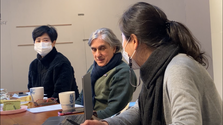Gimpo, South Korea
Borders : Visible/Invisible

유기적 경계
우리는 누구나 경계를 가지고 있다. 인간이든 국가든 혹은 이념이든 인간은 계급과 분류를 통해서 자신들의 위치를 파악하고 거기에 맞는 권리와 의무를 이행하는 게 익숙한 사회에 살고 있다.
그러나 코로나로 인해 우리는 그간 보이지 않았던 솔직히 말하면 알고 있지만 드러내지 않았던 경계가 수면에 올라온 것을 직감했다.
최근 몇 년간 전 인류는 아시안 헤이트(Asian Hate), 블랙 라이브 메터(Black Lives Matter)와 같은 인종의 문제부터 아르메니아와 아르젠바이잔의 국경분쟁, 중국와 미국의 경제 분쟁 등 다양한 이슈로 수없이 경계선을 그었고 극렬하게 드러냈다.
과연 국경이란, 경계란 무엇인가? 경계를 만들어 내는 가장 큰 요인 중 하나는 이전에 내려온 역사에 의해서 학습된 기억에서 오는 경계, 국가의 이권에 따라 정의 내려진 분쟁의 국경들이다. 이것들은 그 시기와 다른 계산법에 따라 또 변한다.
예를 들면, 9년 동안 여성인권 전시를 진행하면 가장 먼저 나에게 다가왔던 질문은 '과연 우리만 피해자인가? 우리에게만 아픈 역사가 있는 것일까?' 라는 것이었다.
다양한 국적의 작가들과 이민의 국가인 미국에서 전시를 진행하면서 일제 강점기나 위안부 같은 일들이 우리만이 가진 역사가 아니라는 것을 알게 되었다. 같이 작업한 글렌데일시 Glendale ReflectSpace 큐레이터 아나히드 오샤간(Anahid Osahgan)와 아라 오샤간(Ara Osahgan) 역시 미국인이지만 아르메니안으로써 뿌리 깊은 상처가 있는 민족의 후예라는 것, 심지어 세 가구 걸러 한집이 아르메니아 대학살의 희생자라는 사실을 알게 되었다.
항상 우리는 우리만이 피해자라고 이야기하지만 정작 많은 나라들이 그와 같은 아픈 역사의 기억을 가지고 있고 그 후손들은 선대가 겪었던 트라우마들을 간, 직접적인 방법으로 물려받는다. 문화적 유전처럼 우리는 한 번도 경험해 보지 못한 과거의 문제들과 사건들을 고스란히 답습하고 트라우마로 남은 기억의 잔재로 인해 실시간으로 일어나는 세계 뉴스에 반응한다.
이번 국제교류 프로젝트를 준비하면서 임지현 교수님과의 만남을 통해 이것이 ‘기억의 정치’라는 것을 알게 되었다. 국가가 개입해서 기억에 대해 재구성을 통해 각 민족이 자신들의 이익 논리에 유리하도록 하는 것을 의미하는데, 특히 냉전 시대, 역사적 행위자들은 기억을 프레임화하여 그들이 원하는 방향으로 가도록 했다고 한다.
그 기억의 프레임을 통해서 우리는 피해자가 된 것이고 가해국이 만들어지는 것이다. 물론 역사적으로 확연히 나눠진 피해자, 가해자-한국과 일본처럼-있지만 그런 조작된 기억들은 큰 효과를 거두지 못했다고 한다. 그도 그럴 것이 작가들의 작업을 보면 국가가 제시하는 방향이 아닌 작가만의 시각이 존재하기에 우리는 그것을 통해 또 다른 민족의 역사관을 엿보게 된다.
Liquid Border
We all have boundaries. Whether it be humans, countries, or ideologies, we live in a society where people are accustomed to identifying their position by rank and classification and carrying out their rights and obligations accordingly.
However, due to the COVID-19 pandemic, we felt intuitively that the boundaries that we had not seen, or more frankly, the boundaries that we had known to exist but had not disclosed, rose to the surface.
Over the past few years, all mankind drew boundaries and vehemently disclosed them for various issues, from racial issues such as Asian Hate and Black Lives Matter, to the border dispute between Armenia and Azerbaijan and the economic dispute between China and the US.
What is a border, or, a boundary? One of the biggest factors that create boundaries is the boundary drawn from memories learned from the history that is passed down, or the border of dispute that is defined by national interest. These again change over time as calculation methods evolve.
For instance, while directing exhibitions on women’s rights for nine years, the first question that dawned upon me was ‘Are we the only victims? Are we the only ones with a painful history?’
While holding exhibitions with artists from various nationalities and in the US, the country of immigrants, I realized that issues such as the Japanese occupation of Korea and comfort women were not only of our own history. I learned that the curators of Glendale ReflectSpace, Anahid Oshagan and Ara Oshagan, whom I collaborated with, were Americans but also Armenians, descendants of a people with a deep-rooted wound, and that one out of three households were victims of the Armenian genocide.
We always and solely think that we are the victims, but in fact, many countries have the memory of such painful history, and future generations inherit the trauma of their ancestors both in direct and indirect ways. Like cultural genetics, we fixate on historical issues and events that we did not experience ourselves, and respond to world news that occurs in real time due to the remnants of memories that remain as a trauma.
While preparing for this international exchange project, I learned through my encounter with Professor Lim Jie-hyun that this is called the ‘politics of memory.’ This refers to state intervention in which memory is reconstituted so that each nation creates a logic that is most favorable to its own interest. Especially during the Cold War era, historical actors constructed a frame of memories to lead events in the direction of their desire.
Through this frame of memories, we become the victim and a perpetrating country is created. Of course, there are historical cases where the victim and the perpetrator are clearly divided, such as Korea and Japan. However, fabricated memories have not had much effect. This is because, in the work of artists, we can see the unique perspective of the artist, not the direction presented by the state, so through this, we have a glimpse of the historical view of another people.
리플렉트플레이스 갤러리 아라 오샤간 큐레이터와 함께한 좌담회
현장답사

















